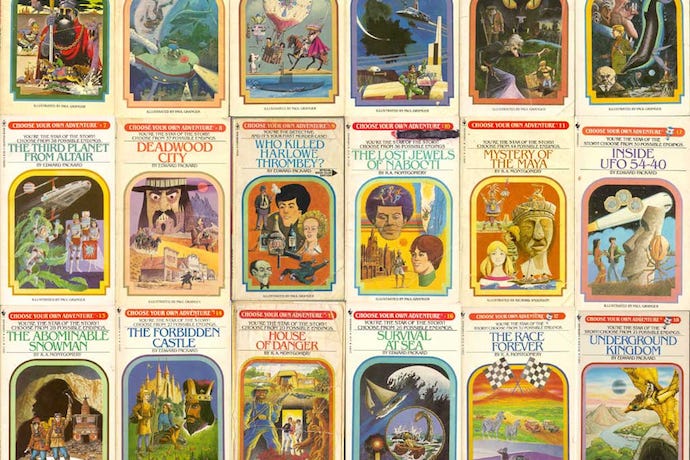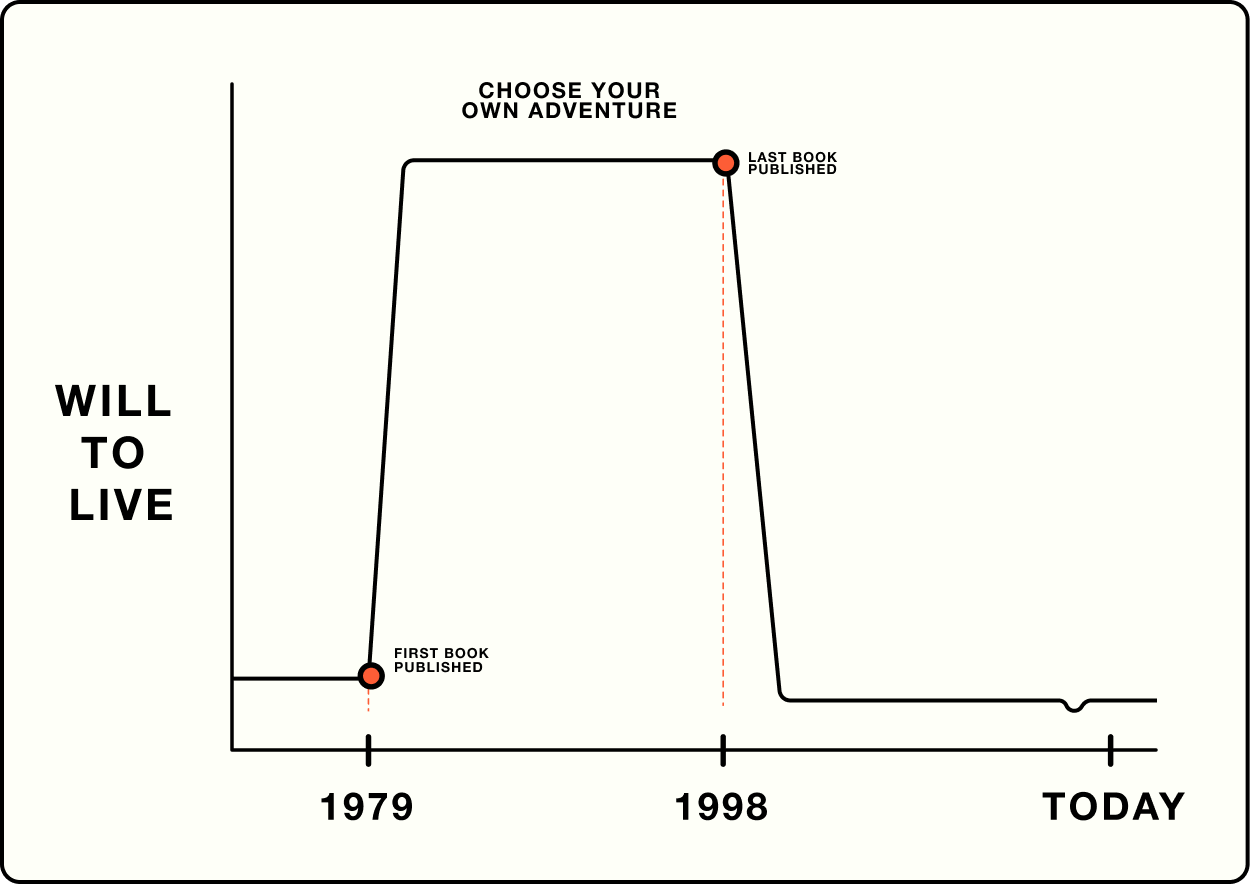Choose Your Own Adventure®
YOU and YOU ALONE are in charge of what happens in this story.
You’re a big wave internet surfer, paddling the Substack Sea for the most colossal, mind-blowing stories.
Suddenly, the water swells around you. Waves churn and suck you under. The other surfers around you are being dragged into an enormous whirlpool. You try to stay afloat but the current is too powerful. The rescue boat is nowhere in sight.
If you decide to battle the current in hopes of swimming back to shore, scroll to page 4.
If you decide to rest and let the vortex take you knowing you may drown, scroll to page 11.
Page 4
You are tired and frightened. Your arms are in agony from your frantic paddling and you’re about to give up when you hear a voice in the distance.
“Oy you, catch this!” someone shouts. A circular buoy lands perfectly over your head. You grab hold of it in disbelief. You nearly died, but you’re safe now. Others were not so lucky.
A hulking man reels you in from the deck of an enormous pirate ship.
Welcome back to the The Worldbuilding Hall of Fame, the sporadic series where we celebrate the pop culture phenomenons made famous by their exceptional worldbuilding. Think Y2K computer games, celebrity personas, consumer brands, retail stores, cursed airports, and cults.
I’ve said it before and I’ll say it again: Worldbuilding is not limited to the sci-fi and fantasy genre. It’s all around us. It could be anywhere. It's like trying to catch smoke... like trying to catch smoke with your bare hands.
Today, we’re talking about the Choose Your Own Adventure series—the beloved, interactive 184-book children’s series published between 1979-1998 that sold over 250 million copies.
What made Choose Your Own Adventure so special?
The Illusion of Control
In 1974, Edward Packard was certain he would find a publisher for his innovative children’s book, Sugar Cane Island. But the most common feedback he got was, “This is really more of a game than a novel.”
That’s because he wrote using a groundbreaking format now referred to as the ‘Gamebook’ style. You, the reader, control the story and make life-or-death choices for the protagonist (also you). All 180+ books have multiple story paths and endings.
The format had such a stronghold on the 80’s-90’s youths that in 2018, Netflix tried to win us over via nostalgia with a gamified Black Mirror episode called Bandersnatch. They then immediately got sued by the CYOA trademark holder.
I don’t know about you, but as a child who had to kiss all my stuffed animals with the same pressure and fervor every night or I would surely die in my sleep, the feeling of complete control over my destiny was very appealing.
Mind-bending Cover Art
Listen, as a graphic designer I have to say they do not make them like they used to. I encourage you to zoom in on these insane retro-pulp-sci-fi-vintage-adventure illustrations.
Any questions coming up for you? Sure, I’ll start. Who’s big-chin guy? Where’d that kid get those jeans with the gorgeous mid-leg seam? What are those little Mucinex germs and carrot squids doing underground? (I believe that is a never-before-typed sentence). Am I having feelings of attraction to the blonde guy double-fisting big gun and little gun, or am I just tired? The answer to all of these questions is yes.
While I do believe we’re at the beginning of a book cover renaissance, I’m not sure we’ll ever make it back to the incredible chaos and delight of Raging Bull in Relatable Middle-Class Suburban Home.
If you’d like to do your own exploring, here’s a Ranking of all 185 Choose Your Own Adventure Books based on title alone.
Second-Person Narrative
It’s an unpopular style. When Edward Packard initially tried to get the first of the series published, he was turned away again and again. He was told it was too experimental, unnerving, or confusing for the reader.
''When my agent left and three children's book agents turned me down flat, I put 'Sugar Cane Island' in a desk drawer for five years,'' Mr. Packard said. (NYT, 1981)
When he finally found someone (Bantam Books) to take a chance on him, it paid off in spades. And he wasn’t the first or the last to make use of the second-person narrative.
If after staring at yourself on Zoom for 6 hours, going to yoga, crying in therapy, and writing a think-piece on Substack, you still want to think about yourself, here are some other delightful second-person books you may enjoy:
Broken Earth Trilogy by N.K. Jemisin, Raven Tower by Ann Leckie, or If On a Winter's Night a Traveler by Italo Calvino. (These are not representative of the ‘Book Cover Renaissance’ I alluded to earlier).
Spiritual Lore
As you know from my diatribe about Neopets and Scientology, every iconic and immersive fictional world has religious or cultish undertones.
Isn’t it fascinating then, that R.A. Montgomery, the writer of 50+ CYOA books devoted much of his career to the spiritual practice of decision-making? He wove his knowledge of Zen Buddhism and Christianity into his many projects around game theory and simulation design. (Also, he was kicked out of Yale Divinity School for spending too much time skiing and mountain climbing).
If you’d choose ditch Letters From Paul to the Corinthians 101 to ski Mohawk Mountain, press the Like button.
If you’d like to sit at the right hand of the Father, press ‘Restack’.
Once when asked about the mission of the Choose Your Own Adventure series, Montgomery said, “Implicit in the choice is an ethical or moral approach or decision… I had always hoped that this would make some profound changes in the way that people make decisions about their lives, about the lives of their children, about politics [and] all the rest. And I’m still very optimistic about that.”
He seems to be a very special, wise, and joyous human. Here is his obituary with the most legendary photograph too.
Aspirational Deaths
Some of the deaths in this series were so out of pocket. I just love that they were like, yes, the children will love this. Here are some of my favorites.
"You float helplessly through space forever."
Journey Under the Sea (1979) - I already feel like I’m doing this but okay.
"You are eaten by the T-Rex.”
The Lost Jewels of Nabooti (1982) – simple but evocative.
“You fall through a trapdoor into a bottomless pit."
House of Danger (1982) - Okay this one is lowkey terrifying because I guess you’d just eventually starve to death?
"You were wrong to trust them. Now you’re doomed.”
The Abominable Snowman (1982) - it’s giving ‘et tu, Brute?????
"The flames grow higher, and there is no escape."
The Cave of Time (1979) - Queue Eagles of Death Metal
"You are frozen in a block of ice, preserved for eternity."
The Abominable Snowman (1982) ~Cryogenically Frozen slay~
"You are sucked into a black hole and vanish from existence."
Space and Beyond (1980) - Me when I go on Tiktok.
"You turn to stone, doomed to be a statue forever."
The Secret of the Pyramids (1983) - Doomed? This is the bare minimum.
Thank you for stopping by The Worldbuilding Hall of Fame. Just so you know, this isn’t my regularly scheduled content. I write bi-weekly Flash Fantasy stories and prompts most of the time. But this is a special occasion (I was feeling inspired).
There are many new folks here. Welcome, I am so glad you’re here. We are pitching tents and building yurts and igloos and carbonite refrigerators for you to sleep in. There’s always room at Fantasy Camp™.
And now, finally, a lovely life lesson:
“Life isn’t a Choose Your Own Adventure, but these books prepared you to feel exhilarated and terrified by all the choices you would someday make. They gave you a way to understand that no ending is really an ending. After every ending, you have to figure out what to do next.” (New Yorker, 2022)
May we all float helplessly through space forever,
Madeleine








